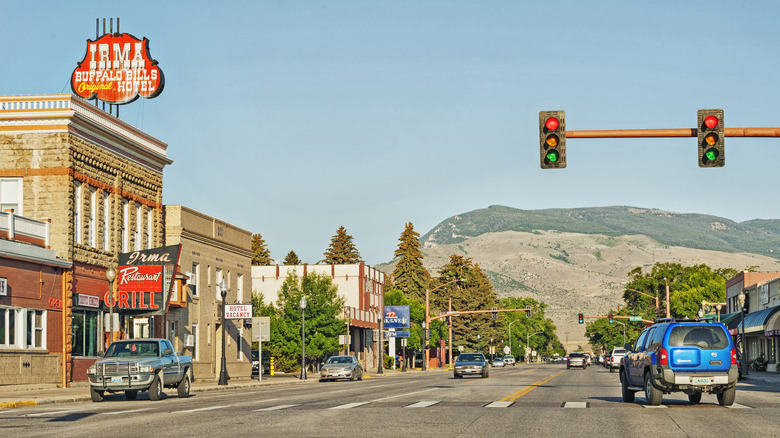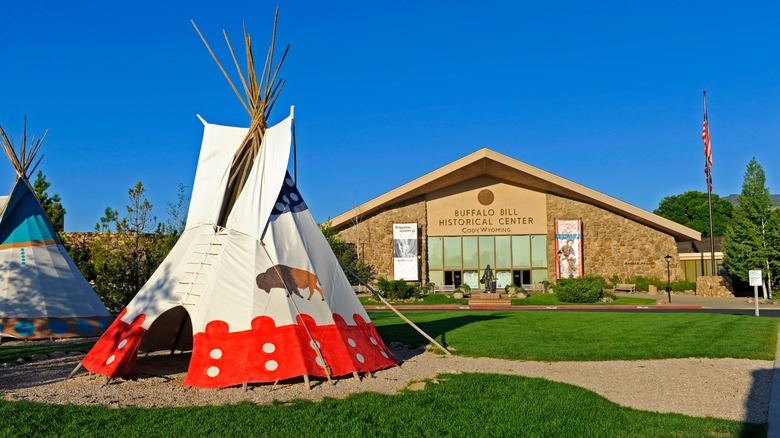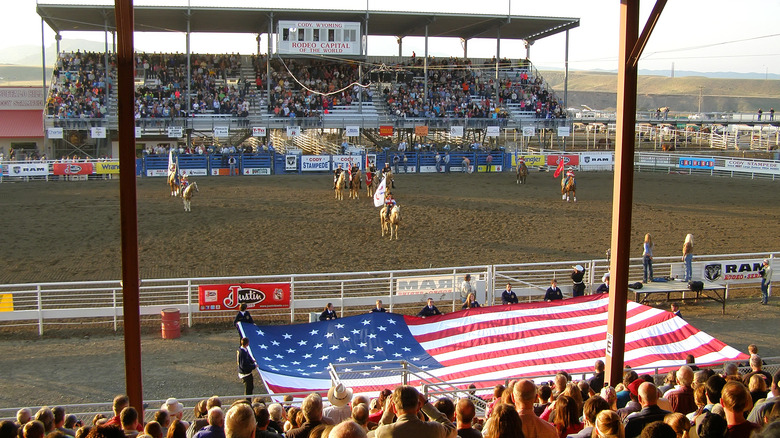This Scenic Town Known As The World's Rodeo Capital Is A Great Gateway To Yellowstone
When you've made up your mind to visit America's first national park, Yellowstone, it immediately raises the question of which side of the park you'll be entering. Yellowstone is bigger than the state of Rhode Island, with five different entrances spread out across 2.2 million acres in Wyoming, Idaho, and Montana. For a break from the crowds, the east entrance has been called the most scenic, with over 50 miles of untamed wilderness between it and the nearest city: Cody, Wyoming. Named after the famous Old West figure, "Buffalo Bill" Cody, the city has maintained its connection to his era with museums, a historic hotel, a recreated frontier town, and more. In the summer, Cody doubles as the "Rodeo Capital of the World" when it's a nightly event.
Compare that with your other options for accessing Yellowstone. The park's west entrance is its busiest, as it provides access to geysers like Old Faithful. However, despite its appeal as one of the world's largest log structures, the Old Faithful Inn isn't the best option for a budget-friendly stay in Yellowstone. You should also note that the nearby Biscuit Basin, a popular tourist spot, is closed in 2024 after a hydrothermal explosion damaged its boardwalk.
Only Yellowstone's north entrance is open year-round, but its popularity could be a drawback if you're hoping to commune with nature and wildlife more than other tourists. For these and other reasons, the road out of Cody might be a better Yellowstone gateway, and it helps that the city is a worthwhile destination in and of itself.
Relive the American West in Cody, Wyoming
Tripadvisor reviews call Cody's Buffalo Bill Center of the West a "can't miss venue" that's "time well spent," with a ticket buying you two consecutive days to explore five Smithsonian-affiliated museums. In the Buffalo Bill Museum, you'll see exhibits and artifacts like a full-size stagecoach from Bill's traveling Wild West show and a 28-foot-long poster of Queen Victoria welcoming him to London. The Plains Indian Museum has an authentic buffalo hide tipi from the Nez Perce Tribe, while the Cody Firearms Museum houses everything from an 18th-century blunderbuss to a 19th-century Gatling gun.
In the summer, the Buffalo Bill Center of the West hosts chuckwagon dinners, where you can enjoy a frontier meal of steak, beans, biscuits, and cobbler. The Draper Natural History Museum has taxidermized animals on display, including gray wolves and a grizzly bear who starred in a documentary narrated by Robert Redford. The wildlife goes two-dimensional in the Whitney Western Art Museum, where portraits of Bill also burnish his legacy as a hunter who earned his nickname by slaughtering over 4,000 buffalo in an 18-month period.
Outside the Buffalo Bill Center of the West, another local museum worth checking out is the Cody Dug Up Gun Museum. It showcases 1,000-plus weapons from the Gold Rush to World War II. The Old Trail Town is an immersive outdoor museum with reassembled historic buildings, such as a saloon and log cabins used by Butch Cassidy and the Sundance Kid.
Cody onstage, in the rodeo arena, and beyond
When you learn more about Buffalo Bill as an emblem of the "Wild West," it becomes apparent that he helped write the myth of it through his show of that name. While parts of Cody project the image of small American towns stuck in time, it's been lived and curated outside of museums, too. At the Rocky Mountain Dance Theatre, that spirit lives on in "Wild West Spectacular: The Musical," a live show that retells Bill's legend via song and dance.
If the show's stage performers seem too photogenic and you'd rather see cowboys and cowgirls with more dirt (or clown makeup) on their faces, head to the Cody Stampede Rodeo. For over a century, it's been sending riders out on broncos and bulls, with the Cody Nite Rodeo event drawing spectators every evening from June to August. This is why Cody is considered the world's rodeo capital.
For a place to stay in Cody, try the Irma Hotel, which is on the National Register of Historic Places. When you leave its renowned cherrywood bar for Yellowstone, you can marvel at the sight of the Buffalo Bill Dam before traveling the Buffalo Bill Scenic Byway. This route is sometimes hyped as "the 50 most beautiful miles in America," though the attribution of that quote to the 26th U.S. president, Theodore Roosevelt, is likely a tall tale. The byway starts near Shoshone National Forest, the first national forest in the U.S.


